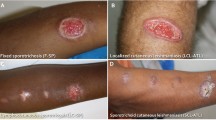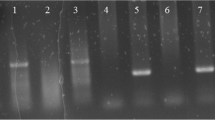Abstract
American cutaneous leishmaniasis (ACL) is a chronic infectious disease caused by different protozoan species of Leishmania, and it is endemic in both tropical and subtropical countries. Using immunohistochemistry, we investigate the density of CD68+, lysozyme+, CD1a+, factor XIIIa+, CD4+, CD8+, CD56+, interferon (IFN)-γ+, and inducible NO synthase (iNOS+) cells. These cells were analyzed from 22 biopsy samples obtained from the lesions of ACL patients, whose infection was caused by Leishmania (Viannia) spp. Histopathological analysis showed dense mononuclear inflammatory infiltration in the dermis, which was composed of lymphocytes, macrophages, plasma cells, and discrete tissue parasitism. Granulomatous reactions were also present in the majority of cases. The density of the activated macrophages was higher than that of inactivated macrophages in the lesions. The density of Langerhans cells (CD1a+) was lower than that of dermal dendrocytes (factor XIIIa+). The density of CD8+ T lymphocytes was higher than that of CD4+ T lymphocytes. The cellular density of these immunological markers in relation to the species of Leishmania demonstrated that L. (Viannia) sp. lesions had higher IFN-γ expression than that Leishmania (Viania) braziliensis lesions. The evaluation of these markers, according to disease progression, did not reveal any significant differences. L. (Viannia) sp. infection leads to a favorable immune response in the host, as predominantly represented by lysozyme+, factor XIIIa+, CD8+ T cells, and the expression of (IFN)-γ+ at the lesion site.



Similar content being viewed by others
References
Anderson CF, Lira R, Kamhawi S, Belkaid Y, Wynn TA, Sacks D (2008) IL-10 and TGF-beta control the establishment of persistent and transmissible infections produced by Leishmania tropica in C57BL/6 mice. J Immunol 180:4090–4097
Barral A, Costa JM, Bittencourt AL, Barral-Netto M, Carvalho EM (1995) Polar and subpolar diffuse cutaneous leishmaniasis in Brazil: clinical and immunopathologic aspects. Int J Dermatol 34:474–479
Belkaid Y, Hoffmann KF, Mendez S, Kamhawi S, Udey MC, Wynn TA, Sacks DL (2001) The role of interleukin (IL)-10 in the persistence of Leishmania major in the skin after healing and the therapeutic potential of anti-IL-10 receptor antibody for sterile cure. J Exp Med 194:1497–1506
Biedermann T, Zimmermann S, Himmelrich H, Gumy A, Egeter O, Sakrauski AK, Seegmüller I, Voigt H, Launois P, Levine AD, Wagner H, Heeg K, Louis JA, Röcken M (2001) IL-4 instructs TH1 responses and resistance to Leishmania major in susceptible BALB/c mice. Nat Immunol 2:1054–1060. doi:10.1038/ni725
Bittencourt AL, Barral A (1991) Evaluation of the histopathological classifications of American cutaneous and mucocutaneous leishmaniasis. Mem Inst Oswaldo Cruz 86:51–56
Bogdan C, Gessner A, Solbach W, Röllinghoff M (1996) Invasion, control and persistence of Leishmania parasites. Curr Opin Immunol 8:517–525
Bogdan C, Röllinghoff M, Diefenbach A (2000) The role of nitric oxide in innate immunity. Immunol Rev 173:17–26
Bosque F, Saravia NG, Valderrama L, Milon G (2000) Distinct innate and acquired immune responses to Leishmania in putative susceptible and resistant human populations endemically exposed to L. (Viannia) panamensis infection. Scand J Immunol 51:533–541
Brodskyn CI, Barral A, Boaventura V, Carvalho E, Barral-Netto M (1997) Parasite-driven in vitro human lymphocyte cytotoxicity against autologous infected macrophages from mucosal leishmaniasis. J Immunol 159:4467–4473
Coutinho SG, Da-Cruz AM, Bertho AL, Santiago MA, De-Luca P (1998) Immunologic patterns associated with cure in human American cutaneous leishmaniasis. Braz J Med Biol Res 31:139–142
Cunha CF, Ferraz R, Pimentel MIF, Lyra MR, Schubach AO, Da-Cruz AM, Bertho AL (2016) Cytotoxic cell involvement in human cutaneous leishmaniasis: assessments in active disease, under therapy and after clinical cure. Parasite Immunol 38:244–254. doi:10.1111/pim.12312
da Silva SC, Brodskyn CI (2014) The role of CD4 and CD8 T cells in human cutaneous leishmaniasis. Front Public Health 2:165. doi:10.3389/fpubh.2014.00165
Da-Cruz AM, Bittar R, Mattos M, Oliveira-Neto MP, Nogueira R, Pinho-Ribeiro V, Azeredo-Coutinho RB, Coutinho SG (2002) T-cell-mediated immune responses in patients with cutaneous or mucosal leishmaniasis: long-term evaluation after therapy. Clin Diagn Lab Immunol 9:251–256
Da-Cruz AM, Conceição-Silva F, Bertho AL, Coutinho SG (1994) Leishmania-reactive CD4+ and CD8+ T cells associated with cure of human cutaneous leishmaniasis. Infect Immun 62:2614–2618
de Moura TR, Novais FO, Oliveira F, Clarêncio J, Noronha A, Barral A, Brodskyn C, de Oliveira CI (2005) Toward a novel experimental model of infection to study American cutaneous leishmaniasis caused by Leishmania braziliensis. Infect Immun 73:5827–5834. doi:10.1128/IAI.73.9.5827-5834.2005
Duarte ML, Rochael MC (2006) Histopathological and immunohistochemical profile of the American cutaneous leishmaniasis with emphasis on FXIIIa+ dermal dendrocytes Perfil histopatológico e imuno-histoquímico da leishmaniose tegumentar Americana com ênfase nos dendrócitos dérmicos FXIIIa+. An Bras Dermatol 81:541–548. doi:10.1590/s0365-05962006000600005
Díaz NL, Arveláez FA, Zerpa O, Tapia FJ (2006) Inducible nitric oxide synthase and cytokine pattern in lesions of patients with American cutaneous leishmaniasis. Clin Exp Dermatol 31:114–117. doi:10.1111/j.1365-2230.2005.01991.x
Favali C, Tavares N, Clarêncio J, Barral A, Barral-Netto M, Brodskyn C (2007) Leishmania amazonensis infection impairs differentiation and function of human dendritic cells. J Leukoc Biol 82:1401–1406. doi:10.1189/jlb.0307187
Goto H, Lauletta Lindoso JA (2012) Cutaneous and mucocutaneous leishmaniasis. Infect Dis Clin N Am 26:293–307. doi:10.1016/j.idc.2012.03.001
Gutierrez Y, Salinas GH, Palma G, Valderrama LB, Santrich CV, Saravia NG (1991) Correlation between histopathology, immune response, clinical presentation, and evolution in Leishmania braziliensis infection. AmJTrop Med Hyg 45:281–289
Hernández-Ruiz J, Becker I (2006) CD8+ cytotoxic lymphocytes in cutaneous leishmaniasis. Salud Publica Mex 48:430–439
Hochrein H, O'Keeffe M, Luft T, Vandenabeele S, Grumont RJ, Maraskovsky E, Shortman K (2000) Interleukin (IL)-4 is a major regulatory cytokine governing bioactive IL-12 production by mouse and human dendritic cells. J Exp Med 192:823–833. doi:10.1084/jem.192.6.823
Jabbour MN, Issa G, Charafeddine K, Simaan Y, Karam M, Khalifeh H, Habib R, Khalifeh I (2015) The immune microenvironment in cutaneous leishmaniasis. J Eur Acad Dermatol Venereol 29:1170–1179. doi:10.1111/jdv.12781
Kima PE, Soong L (2013) Interferon gamma in leishmaniasis. Front Immunol 4:156. doi:10.3389/fimmu.2013.00156
Liew FY (1994) Regulation of nitric oxide synthesis in infectious and autoimmune diseases. Immunol Lett 43:95–98
Liew FY, Li Y, Severn A, Millott S, Schmidt J, Salter M, Moncada S (1991) A possible novel pathway of regulation by murine T helper type-2 (Th2) cells of a Th1 cell activity via the modulation of the induction of nitric oxide synthase on macrophages. Eur J Immunol 21:2489–2494. doi:10.1002/eji.1830211027
Maspi N, Abdoli A, Ghaffarifar F (2016) Pro- and anti-inflammatory cytokines in cutaneous leishmaniasis: a review. Pathog Glob Health 110:247–260. doi:10.1080/20477724.2016.1232042
Meymandi S, Dabiri S, Dabiri D, Crawford RI, Kharazmi A (2004) A quantitative study of epidermal Langerhans cells in cutaneous leishmaniasis caused by Leishmania tropica. Int J Dermatol 43:819–823. doi:10.1111/j.1365-4632.2004.02359.x
Ministério da Saúde SdVeS (2014) Guia de Vigilância em Saúde. Ministério da Saúde, Brasília-Distrito Federal-Brasil
Morgado FN, Schubach A, Rosalino CM, Quintella LP, Santos G, Salgueiro M, Conceição-Silva F (2008) Is the in situ inflammatory reaction an important tool to understand the cellular immune response in American tegumentary leishmaniasis? Br J Dermatol 158:50–58. doi:10.1111/j.1365-2133.2007.08255.x
Murray HW, Berman JD, Davies CR, Saravia NG (2005) Advances in leishmaniasis. Lancet 366:1561–1577. doi:10.1016/S0140-6736(05)67629-5
Nateghi Rostami M, Keshavarz H, Edalat R, Sarrafnejad A, Shahrestani T, Mahboudi F, Khamesipour A (2010) CD8+ T cells as a source of IFN-γ production in human cutaneous leishmaniasis. PLoS Negl Trop Dis 4:e845. doi:10.1371/journal.pntd.0000845
Qadoumi M, Becker I, Donhauser N, Röllinghoff M, Bogdan C (2002) Expression of inducible nitric oxide synthase in skin lesions of patients with american cutaneous leishmaniasis. Infect Immun 70:4638–4642
Rodrigues FM, Coelho Neto GT, Menezes JG, Gama ME, Gonçalves EG, Silva AR, Laurenti MD, Corbett CE, Silveira FT, Gomes CM (2014) Expression of Foxp3, TGF-β and IL-10 in American cutaneous leishmaniasis lesions. Arch Dermatol Res 306:163–171. doi:10.1007/s00403-013-1396-8
Rogers KA, DeKrey GK, Mbow ML, Gillespie RD, Brodskyn CI, Titus RG (2002) Type 1 and type 2 responses to Leishmania major. FEMS Microbiol Lett 209:1–7
Salud OPdl (2015) Informe Epidemiológico de las Américas. Leishmaniasis vol 1. World Health Organization. Regional Office for the Americas, Washington, DC
Santos Cda S, Boaventura V, Ribeiro Cardoso C, Tavares N, Lordelo MJ, Noronha A, Costa J, Borges VM, de Oliveira CI, Van Weyenbergh J, Barral A, Barral-Netto M, Brodskyn CI (2013) CD8 (+) granzyme B (+)-mediated tissue injury vs. CD4 (+) IFNγ(+)-mediated parasite killing in human cutaneous leishmaniasis. J Invest Dermatol 133:1533–1540. doi:10.1038/jid.2013.4
Silveira FT, Lainson R, Corbett CE (2004) Clinical and immunopathological spectrum of American cutaneous leishmaniasis with special reference to the disease in Amazonian Brazil: a review. Mem Inst Oswaldo Cruz 99:239–251. doi:10.1590/S0074-02762004000300001
Silveira FT, Lainson R, De Castro Gomes CM, Laurenti MD, Corbett CE (2009) Immunopathogenic competences of Leishmania (V.) braziliensis and L. (L.) amazonensis in American cutaneous leishmaniasis. Parasite Immunol 31:423–431. doi:10.1111/j.1365-3024.2009.01116.x
Silveira FT, Lainson R, Gomes CM, Laurenti MD, Corbett CE (2008) Reviewing the role of the dendritic Langerhans cells in the immunopathogenesis of American cutaneous leishmaniasis. Trans R Soc Trop Med Hyg 102:1075–1080. doi:10.1016/j.trstmh.2008.05.020
Soong L, Chang CH, Sun J, Longley BJ, Ruddle NH, Flavell RA, McMahon-Pratt D (1997) Role of CD4+ T cells in pathogenesis associated with Leishmania amazonensis infection. J Immunol 158:5374–5383
Soong L, Henard CA, Melby PC (2012) Immunopathogenesis of non-healing American cutaneous leishmaniasis and progressive visceral leishmaniasis. Semin Immunopathol 34:735–751. doi:10.1007/s00281-012-0350-8
Sotto MN, Halpern I, Kauffman MR, Pagliari C (2010) Factor XIIIa+ dermal dendrocyte parasitism in American tegumentary leishmaniasis skin lesions. Am J Dermatopathol 32:15–18. doi:10.1097/DAD.0b013e3181ab4695
Stager S, Alexander J, Kirby AC, Botto M, Van Rooijen N, Smith DF, Brombacher F, Kaye PM (2003) Natural antibodies and complement are endogenous adjuvants for vaccine-induced CD8(+) T-cell responses. Nat Med 9:1287–1292. doi:10.1038/nm933
Acknowledgments
The authors greatly acknowledge Thaíse Yumie Tomokane for editing the figures and performing the statistical analyses. Financial support was provided by the São Paulo Research Foundation (FAPESP) Grant #2006/56319-1, as well as by the Laboratório de Patologia de Moléstias Infecciosas (LIM-50/HCFMUSP). English-language editing of this manuscript was provided by Journal Prep.
Author information
Authors and Affiliations
Corresponding author
Ethics declarations
This study was approved by the Ethics Committee of the Clinic’s Hospital, University of São Paulo Medical School (#0485/08). Informed consent was obtained from all participants in the study.
Conflict of interest
The authors declare that they have no conflict of interest.
Rights and permissions
About this article
Cite this article
Castro Gomes, C.M., Sousa, M.G.T., Menezes, J.P.B. et al. Immunopathological characterization of human cutaneous leishmaniasis lesions caused by Leishmania (Viannia) spp. in Amazonian Brazil. Parasitol Res 116, 1423–1431 (2017). https://doi.org/10.1007/s00436-017-5403-4
Received:
Accepted:
Published:
Issue Date:
DOI: https://doi.org/10.1007/s00436-017-5403-4




